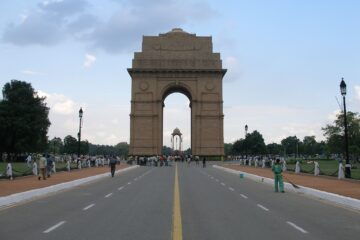COVID-19 and subsequent lockdowns have amplified Canada’s inequalities in resources, wealth, and — notably — access to medical services, with the nation as a whole growing cognizant of these social and economic disparities. This is particularly acute in Northern Canada (encompassing Yukon, Northwest Territories, and Nunavut), which has long struggled with limited access to health resources and a lack of assistance from the Canadian government. The increased burden brought about by COVID-19 is only the latest example in Canada’s long-standing history of health inequality in Canada’s Northern regions. Nunavut’s recent COVID-19 outbreaks exemplify the ineptitude of the Canadian government in ensuring that residents of Northern Canada have adequate access to the healthcare and resources they require in order to cope with the virus and its impacts. Given that the region hosts higher proportions of Indigenous communities than the rest of Canada, Indigenous communities are also disproportionately impacted by health inequalities.
Health Inequality in Northern Canada
Health inequalities are defined as “the unjust and avoidable differences in people’s health across the population and between specific population groups.” Health inequality is inherently connected to access to health resources and social services, including access to healthcare, access to a social safety net, food security, and access to quality housing. Despite outside observers often lauding Canada for their universal healthcare system, health inequalities are nevertheless prevalent and even increasing in much of Canada, especially in the North. As outlined in a Public Health Agency of Canada Executive Summary, these inequalities are often due to individuals and groups’ relative social, economic, political, and geographic limitations. According to the report, these inequalities have the capacity to affect people’s chances of maintaining good health over the course of their lifetime. Several Canadian studies have shown that the main determinants of health are not rooted in medical or behavioural factors, but rather in a host of socio-economic and environmental determinants that expose individuals to various health risks and barriers. In Canada, racialized, immigrant and refugee groups are most at risk for the negative effects that result from health inequality.
The comparatively remote nature of Northern Canada has made the region especially vulnerable to health inequalities. According to a discussion paper focused on reducing health disparities prepared by the Health Disparities Task Group of the Federal/Provincial/Territorial Advisory Committee on Population Health and Health Security, people living in Northern Canada’s remote communities have the lowest disability-free life expectancy (DFLE) and lowest life expectancy in the country; their rates of smoking, obesity and heavy drinking are above Canadian averages; and infant mortality rates among remote Indigenous communities in the North are 1.3 to 3.1 times the national rate. Such ongoing systemic health inequalities are not only exacerbated by the COVID-19 pandemic, but also make the population more vulnerable to the virus given that underlying medical conditions put individuals at greater risk of severe illness from COVID-19.
Nunavut and the Coronavirus
Nunavut’s recent coronavirus outbreak highlights the consequences of long-standing health disparities in Canada’s North. Throughout the month of November, COVID-19 cases in Nunavut climbed, mostly impacting the four communities of Arviat, Rankin Inlet, Whale Cove and Sanikiluaq. Notably, none of Nunavut’s communities with COVID-19 infections have a hospital; the only hospital in Nunavut, located in Iqaluit, is thousands of kilometres away from some of the communities most impacted by COVID, and does not even have an intensive care unit. Due to this, residents who get seriously ill are required to be flown far from home in order to receive specialized care. Not only is this inconvenient for the individuals involved, but it is a costly procedure. Barry Pakes, an assistant professor at the University of Toronto’s Dalla Lana School of Public Health, emphasizes how concerning these conditions are, telling the CBC, “The thing that everyone is worried about is the fact that medical infrastructure to care for people who are severely ill is really quite limited in some places.”
While residents of Nunavut are certainly not the only ones disproportionately impacted by COVID-19-related health inequality, inequities in housing and resources that are particular to Nunavut exacerbate the ability to respond to coronavirus outbreaks.
Inadequate Housing and Resources in Nunavut Highlighted by COVID-19
Beyond the unequal distribution of and access to healthcare, there are numerous other contributing factors towards health inequality relevant to Nunavut that disproportionately impact the damage caused by COVID-19. These include Northern overcrowding, lack of access to resources, and lack of access to clean water for sanitation during lockdown. According to an October 2020 study conducted by researchers at the Northern Ontario School of Medicine, cases in remote Northern Indigenous communities are some of the most concerning locations for potential outbreaks due to the presence of so many people in close quarters, making it easier for the virus to spread. The study also accounted for Northern rural housing conditions, which are thought to increase contact rates throughout the region.
Inequalities in Nunavut also result in struggles for residents to cope with COVID-19 lockdowns. For instance, during a recent lockdown, a family of 11 in Arviat was left with a broken boiler and no hot water in their public housing unit for over two weeks. Due to the lockdown, the Nunavut Housing Corporation deemed only emergency repairs possible. Cecilia Akammak told the CBC that she had to boil water in order to wash her family’s hands, and that drinking the water in her home made her children sick.
Nunavut is only one example of a demographic in Canada being disproportionately impacted by COVID-19 due to existing structural health inequalities. In future policy formation and deployment of pandemic relief funds, these inequalities must be taken into account and must inform decisions made by the Canadian government, especially with forthcoming plans to distribute COVID-19 vaccines throughout Canada. Considerations must be made for the more remote areas of Canada’s North, ensuring that the infrastructure to safely transport and store doses of the vaccine is available and efficient. While the federal government is providing immediate assistance to Nunavut’s provincial government, communities and Indigenous partners to address the COVID-19 pandemic, special consideration must be taken in order to account for the specific and persistent vulnerabilities particular to Nunavut.
Edited by Arimbi Wahono.
Featured image by US Embassy Canada, licensed under CC PDM 1.O.




